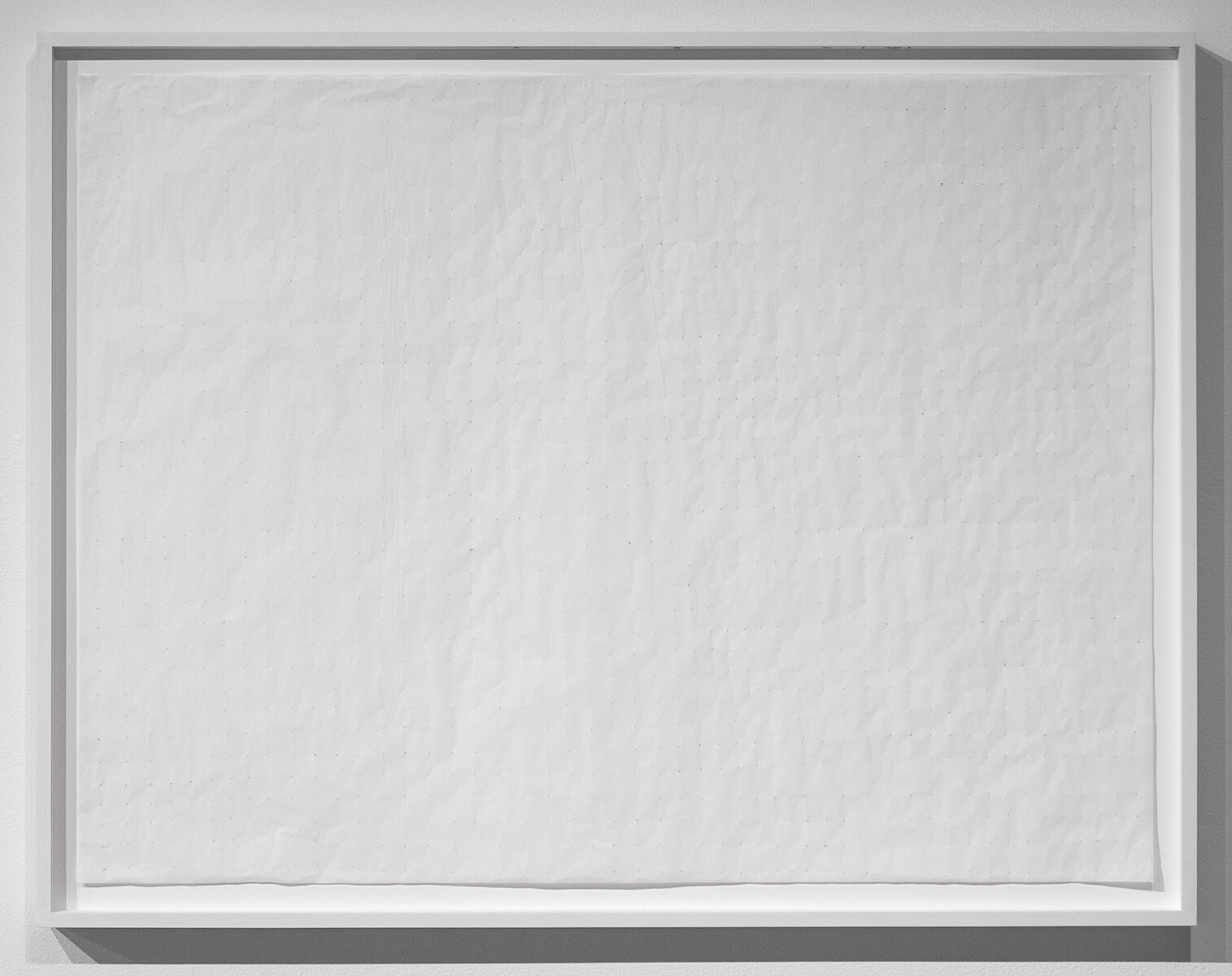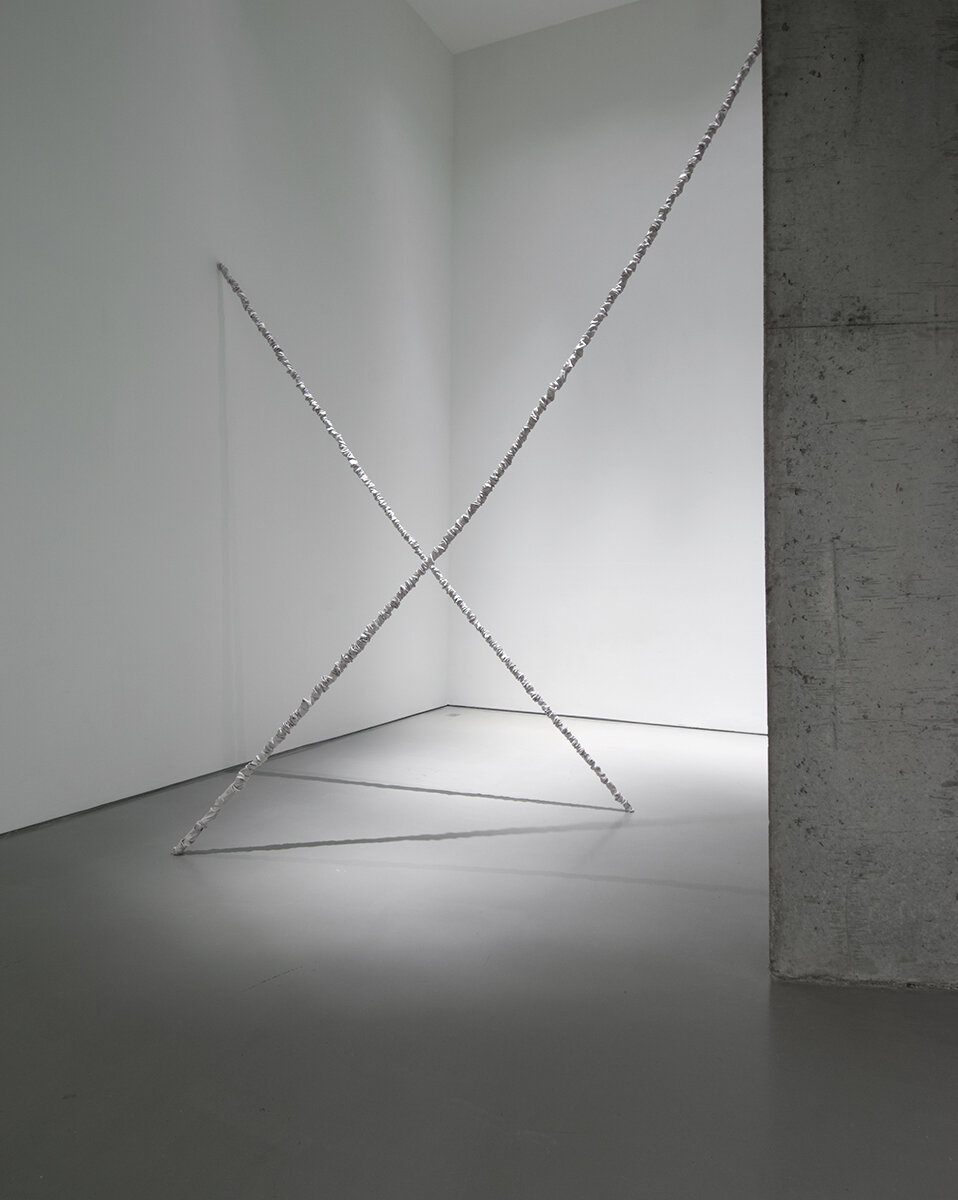Matt Morris
Festoon Drape (for James, Robert, Zaha, Steven, and Eric), 2015
Ruched grey voile curtains
Installed for public viewing at the entrance of the Lower 2 Gallery at the Contemporary Arts Center
Installation view of The Perfect Kiss (QQ)* *questioning, queer
The Perfect Kiss (QQ)*
*questioning, queer
Matt Morris with James Lee Byars
Contemporary Arts Center, Cincinnati, OH
May 15 – October 11, 2015
Bouquets of roses, love notes, commemorative snapshots, boudoir décor: typically associated with romantic courtship, how might these gestures be read when used to remark on relationships that connect the art world? In this installation of works, Matt Morris interprets these forms literally and abstractly in order to consider how connections are made between art histories and contemporary praxis, between exhibitions and the museums who host them, and amongst a global network of collectors, curators, couturiers, and other cultural producers complicit in the scripting of stories that characterize how an artist is understood behind his work. In Morris’ research-driven practice, examinations of recent artistic pasts compel the shape of his work, conjoining conventional modes of object-making (like drawing and photography) with shifting roles of artist-as-curator and scholar.
For his most recent project, Morris considers the life and work of American artist James Lee Byars (1932–1997), seeking to depict an alternative, more softly intimate portrayal than what has been represented in dominant canon. Over several decades, Byars was committed to posing poetic questions and the pursuit of ideas of perfection, problems that are placed here into conversation with Morris’ own inquiries into queer identity. Subverting easy categorization, Byars’ oeuvre includes post-minimalist formal investigations, performance, and a daily ritual of correspondence that merged drawing and flirtatious letter writing. He wrote profusely to curators, collectors, and art world luminaries such as the German artist Joseph Beuys. In many cases these valentine-like texts went unanswered. Morris’ selection of Byars works looks closely at the ephemerality, rejection, and absence that permeates the cultural field in which both artists are positioned—seeking to trace where personal histories and social contexts meet.
Installation view of The Perfect Kiss (QQ)* *questioning, queer,
Foreground: James Lee Byars’The Rose Table of Perfect, 1989, 3,333 red roses, Styrofoam
James Lee Byars, Venice, c. 1980.
Photo courtesy University of California,
Berkeley Art Museum and Pacific Film Archive, gift of Morgan Thomas.
Inkjet print on Mohawk Carnival + Via, Cool White Vellum 100T,
wood, kiss patterned washi tape
Matt Morris
Festoon Drape (for James, Robert, Zaha, Steven, and Eric), 2015
Ruched grey voile curtains
Installed for public viewing at the entrance of the Lower 2 Gallery at the Contemporary Arts Center
Matt Morris
Festoon Drape (for James, Robert, Zaha, Steven, and Eric), 2015
Ruched grey voile curtains
Installed for public viewing at the entrance of the Lower 2 Gallery at the Contemporary Arts Center
James Lee Byars
The Rose Table of Perfect, 1989
3,333 red roses, Styrofoam
IVAM, Institut Valencià d’Art Modern
Matt Morris
this this him them, 2015
Inkjet print mounted onto Sintra
Two rose quartz sphere given to the artist by his twin,
photographed and enlarged to the scale of James Lee Byars’ This This, 1985,
a sculpture currently in the collection of Mr. and Mrs. Leonard Korman, Fort Washington, PA
Cristobal Balenciaga
Evening coat, ca. 1960
Pale pink silk shantung gazar
The Ohio State University
Historic Costume and Textiles Collection
During the 1960s, dancers in Byars’ performances were outfitted in combinations of haute couture and unique designs he concocted with his tailor in New York’s Chinatown who went by the name Mr. North South. Garments by celebrated fashion designers Cristobal Balenciaga and Pierre Cardin were included in such works as a performance with Taki Sachiko in Kyoto in 1962, with Yvonne Rainer at Green Gallery in New York in 1963, and with Lucinda Childs at the Carnegie in Pittsburgh in 1965.
James Lee Byars
Pink silk tail, 1970
Pink silk
Collection of Michael Lowe and Kimberly Klosterman
Cristobal Balenciaga
Evening coat, ca. 1960
Pale pink silk shantung gazar
The Ohio State University
Historic Costume and Textiles Collection
James Lee Byars
Pink circular tissue letter, 1980
Ink on pink tissue, feather
Collection of Michael Lowe and Kimberly Klosterman
James Lee Byars
behind, rose/these, dad/and, top, 1984
Tan paper with silver print
Pencil on four sheets from a fourteen-page letter
Installed with silver ink registration marks on wall
Collection of Michael Lowe and Kimberly Klosterman
Arrange whatever pieces come your way.
–Virginia Woolf. Diary entry for Saturday, September 5,1925
James Lee Byars
behind, 1984
Detail view
Tan paper with silver print
Pencil on four sheets from a fourteen-page letter
Installed with silver ink registration marks on wall
Collection of Michael Lowe and Kimberly Klosterman
James Lee Byars
rose/these, 1984
Detail view
Tan paper with silver print
Pencil on four sheets from a fourteen-page letter
Installed with silver ink registration marks on wall
Collection of Michael Lowe and Kimberly Klosterman
James Lee Byars
dad/and, 1984
Detail view
Tan paper with silver print
Pencil on four sheets from a fourteen-page letter
Installed with silver ink registration marks on wall
Collection of Michael Lowe and Kimberly Klosterman
James Lee Byars
dad/and, 1984
Detail view
Tan paper with silver print
Pencil on four sheets from a fourteen-page letter
Installed with silver ink registration marks on wall
Collection of Michael Lowe and Kimberly Klosterman
James Lee Byars
White heart tissue letters, ca. 1970
crayon on white tissue, two sheets
Collection of Michael Lowe and Kimberly Klosterman
James Lee Byars
White heart tissue letters, ca. 1970
crayon on white tissue, two sheets
Collection of Michael Lowe and Kimberly Klosterman
James Lee Byars
Pink letter, ca. 1982
Gold crayon on pink Japanese paper
Collection of Michael Lowe and Kimberly Klosterman
*w*i*t*h*o*u*t* *y*o*u* *t*h*e* *p*e*r*f*e*c*t* *k*i*s*s*
*w*o*u*l*d* *n*e*v*e*r* *h*a*v*e* *e*x*i*s*t*e*d*
Installation view of The Perfect Kiss (QQ)* *questioning, queer,
On wall: Matt Morris’ The Good Enough Kiss, 2014, iridescent watercolor on Gaylord archival tissue paper;
In vitrine: James Lee Byars’ Crumpled pink tissue letter, date unknown, ink on tissue paper, two parts, and James Lee Byars’ Pink scroll letter, 1977, graphite on toilet paper, Collection of Michael Lowe and Kimberly Klosterman
Matt Morris
The Good Enough Kiss, 2014
Iridescent watercolor on Gaylord archival tissue paper
five sheets
To paraphrase a letter psychoanalyst Donald Winnicott wrote to Roger Money-Kyrle in 1952: I am often thought to be talking about kisses as if they were perfect or as if they were corresponding to “the good kiss” which parallels Melanie Klein’s jargon. Actually I always talk about “the good-enough kiss” or “the not good-enough kiss” because in point of fact we are talking about actual kisses, we know that the best they can be is good enough, and the word “enough” gradually (in favourable circumstances) widens in scope according to one’s growing ability to deal with failure by understanding, toleration of frustrations, etc. The “good kiss” and the “bad kiss” coming from Kleinian jargon are internal objects and are nothing to do with real kisses. The best a real kiss can do with someone is to be sensitively good enough….
Matt Morris
The Good Enough Kiss, 2014
Iridescent watercolor on Gaylord archival tissue paper
five sheets
Matt Morris
The Good Enough Kiss, 2014
Iridescent watercolor on Gaylord archival tissue paper
five sheets, detail view
James Lee Byars
The Perfect Kiss, 1974
Performance
Performer enters gallery, stands and moves their lips almost imperceptibly for several seconds, then exits
Jumex Collection
Matt Morris
archive VI, 2015
All of the vases from Morris’ personal collection
–Two hurricane lamps given by the artist’s parents, used for floral arrangements decorating the reception for Morris’ BFA thesis exhibition at the Art Academy of Cincinnati, 2007.
–Square bud vase with etched striping, gift from parents during freshman year of undergraduate studies. Sibling was given a matching vase.
–White pitcher, delivered with bouquet of sunflowers on the day Morris and Eric Ruschman moved into their first apartment in Chicago in 2011.
–Cylinder glass vase, bought by the artist at Target in 2012 for an art project during graduate school, brought home from studio and used most often for bouquets of two dozen white roses.
–Textured white ceramic cylinder, held arrangement of dahlias given to Morris by Heidi and Matt Joynt as a housewarming gift after a move to his and Eric Ruschman’s current apartment in Chicago, 2013. Morris and Heidi Joynt have previously collaborated on floral components of art projects.
–Brandy glass vase, arrangement of tulips, jasmine, and hydrangea by Heidi Joynt of Field + Florist. Gift on the occasion of my MFA thesis exhibition in 2013.
–White and pink vase that belonged to the artist’s maternal grandmother, Dot Rogers, who passed away in 2006. Vase was damaged and repaired before it was acquired by Morris (and given her frequent visits to garage sales and thrift stores, possibly before his grandmother acquired it).
–White enamel coffee pot that belonged to the artist’s maternal grandmother, Dot Rogers, who passed away in 2006.
–Square glass vase, held floral design by Heidi Joynt of Field + Florist as a gift from the artist’s father.
Matt Morris
I’ll be wearing ribbons down my back this summer, 2015
Photograph made in the Contemporary Arts Center on May 4, 2015 with preparator Reid Radcliffe
Inkjet print
Installation view of Matt Morris’ I’ll be wearing ribbons down my back this summer, 2015, Inkjet print
Installation view of The Perfect Kiss (QQ)* *questioning, queer,
From left: Matt Morris’ The Good Enough Kiss, 2014, iridescent watercolor on Gaylord archival tissue paper; Matt Morris’ Cerebra (Lucinda) and Cerebra (Yvonne), 2015, ruched satin
Matt Morris
Cerebra (Lucinda), 2015
ruched satin
Matt Morris
Cerebra (Yvonne), 2015
ruched satin
I must interrupt here to say that “X” is what exists within me. “X” – I bathe myself in that this. It’s unpronounceable. Everything I don’t know is in “X.” Death? Death is “X.” But a lot of life, too, for life is unpronounceable. “X” that trembles within me, and I fear its diapason…
I hope you live “X” so you can experience the kind of creative drowsiness that slumbers through the veins. “X” is neither good nor bad. It always independs. But it only happens for what has a body. Although immaterial, it needs our body and the body of the thing. There are objects which are that total mystery of “X.” Like what vibrates mutely. The instants are shattered fragments of “X”…
Is the “X” the breath of the it?
–Clarice Lispector. The Stream of Life. Translated by Hélène Cixous. Minneapolis: University of Minnesota Press, 1989. Pp. 65–66.
Matt Morris
Festoon Drape (A Room of One’s Own), 2015
Ruched grey voile curtains
Installed for limited viewing in the Member’s Lounge at the Contemporary Arts Center





























